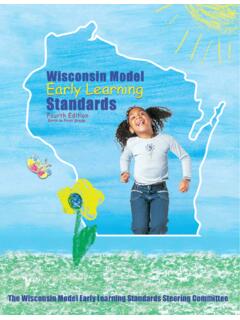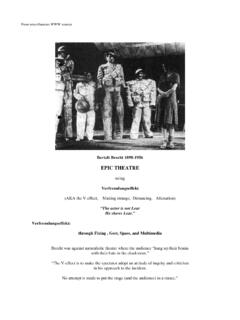Transcription of Your Child at 1 Year - Centers for Disease Control and ...
1 What Most Children Do at this Age:Social/Emotionalq Is shy or nervous with strangersq Cries when mom or dad leavesq Has favorite things and peopleq Shows fear in some situationsq Hands you a book when he wants to hear a storyq Repeats sounds or actions to get attentionq Puts out arm or leg to help with dressingq Plays games such as peek-a-boo and pat-a-cake Language/Communication q Responds to simple spoken requestsq Uses simple gestures, like shaking head no or waving bye-bye q Makes sounds with changes in tone (sounds more like speech)q Says mama and dada and exclamations like uh-oh! q Tries to say words you sayCognitive (learning, thinking, problem-solving) q Explores things in different ways, like shaking, banging, throwingq Finds hidden things easilyq Looks at the right picture or thing when it s namedq Copies gesturesq Starts to use things correctly; for example, drinks from a cup, brushes hairq Bangs two things togetherq Puts things in a container, takes things out of a containerq Lets things go without helpq Pokes with index (pointer) fingerq Follows simple directions like pick up the toy Your Child at 1 YearChild s Name Child s Age Today s DateHow your Child plays, learns, speaks, and acts offers important clues about your Child s development.
2 Developmental milestones are things most children can do by a certain the milestones your Child has reached by his or her 1st birthday. Take this with you and talk with your Child s doctor at every visit about the milestones your Child has reached and what to expect Doesn t crawlq Can t stand when supportedq Doesn t search for things that she sees you Doesn t say single words like mama or dada q Doesn t learn gestures like waving or shaking headq Doesn t point to thingsq Loses skills he once hadTell your Child s doctor or nurse if you notice any of these signs of possible developmental delay for this age, and talk with someone in your community who is familiar with services for young children in your area, such as your state s public early intervention program. For more information, go to or call Early by Talking to Your Child s Doctor if Your Child :Adapted from CARING FOR YOUR BABY AND YOUNG Child : BIRTH TO AGE 5, Fifth Edition, edited by Steven Shelov and Tanya Remer Altmann 1991, 1993, 1998, 2004, 2009 by the American Academy of Pediatrics and BRIGHT FUTURES: GUIDELINES FOR HEALTH SUPERVISION OF INFANTS, CHILDREN, AND ADOLESCENTS, Third Edition, edited by Joseph Hagan, Jr.
3 , Judith S. Shaw, and paula M. Duncan, 2008, Elk Grove Village, IL: American Academy of Pediatrics. This milestone checklist is not a substitute for a standardized, validated developmental screening Development q Gets to a sitting position without helpq Pulls up to stand, walks holding on to furniture ( cruising )q May take a few steps without holding onq May stand aloneLearn the Signs. Act | 1-800-CDC-INFO Qu Hacen los Ni os a Esta Edad?En las reas social y emocionalq Act a con timidez o se pone nervioso en presencia de desconocidosq Llora cuando la mam o el pap se alejaq Tiene cosas y personas preferidas q Demuestra miedo en algunas situacionesq Le alcanza un libro cuando quiere escuchar un cuentoq Repite sonidos o acciones para llamar la atenci nq Levanta un brazo o una pierna para ayudar a vestirseq Juega a esconder la carita y a las palmaditas con las manosEn las reas del habla y la comunicaci n q Entiende cuando se le pide que haga algo sencilloq Usa gestos simples, como mover la cabeza de lado a lado para decir no o mover la mano para decir adi s q Hace sonidos con cambios de entonaci n (se parece m s al lenguaje normal) q Dice mam y pap y exclamaciones como oh-oh q Trata de copiar palabrasEn el rea cognitivia (aprendizaje, razonamiento, resoluci n de problemas)
4 Q Explora los objetos de diferentes maneras (los sacude, los golpea o los tira)q Encuentra f cilmente objetos escondidosq Cuando se nombra algo mira en direcci n a la ilustraci n o cosa que se nombr q Copia gestos q Comienza a usar las cosas correctamente, por ejemplo, bebe de una taza, se cepilla el peloq Golpea un objeto contra otroq Mete cosas dentro de un recipiente, las saca del recipienteq Suelta las cosas sin ayudaq Pide atenci n tocando a las personas con el dedo ndiceq Sigue instrucciones sencillas como recoge el juguete Su Hijo de 1 A oNombre del ni o Edad del ni o Fecha de hoyLa manera en que su hijo juega, aprende, habla y act a nos ofrece pistas importantes sobre c mo se est desarrollando. Los indicadores del desarrollo son las cosas que la mayor a de los ni os pueden hacer a una edad los indicadores del desarrollo que puede ver en su hijo cuando cumple 1 a o de edad.
5 En cada visita m dica de su hijo, lleve esta informaci n y hable con el pediatra sobre los indicadores que su hijo alcanz y cu les son los que deber a alcanzar a continuaci No gatea q No puede permanecer de pie con ayuda q No busca las cosas que la ve esconderq No dice palabras sencillas como mam o pap q No aprende a usar gestos como saludar con la mano o mover la cabezaq No se ala cosas q Pierde habilidades que hab a adquiridoD gale al m dico o a la enfermera de su hijo si nota cualquiera de estos signos de posible retraso del desarrollo para su edad, y converse con alguien de su comunidad que conozca los servicios para ni os de su rea, como por ejemplo el programa p blico de intervenci n temprana patrocinado por el estado. Para obtener m s informaci n, consulte o llame pronto y hable con el doctor de su hijo se el ni o:Tomado de CARING FOR YOUR BABY AND YOUNG Child : BIRTH TO AGE 5, Quinta Edici n, editado por Steven Shelov y Tanya Remer Altmann 1991, 1993, 1998, 2004, 2009 por la Academia Americana de Pediatr a y BRIGHT FUTURES: GUIDELINES FOR HEALTH SUPERVISION OF INFANTS, CHILDREN, AND ADOLESCENTS, tercera edici n, editado por Joseph Hagan, Jr.
6 , Judith S. Shaw y paula M. Duncan, 2008, Elk Grove Village, IL: Academia Americana de Pediatr a. Esta lista de verificaci n de indicadores del desarrollo no es un sustituto de una herramienta de evaluaci n del desarrollo estandarizada y las reas motora y de desarrollo f sico q Se sienta sin ayudaq Se para sosteni ndose de algo, camina apoy ndose en los muebles, la pared, Puede ser que hasta d unos pasos sin apoyarseq Puede ser que se pare soloAprenda los signos. Reaccione | 1-800-CDC-INFO
















